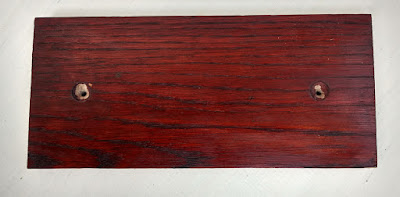 |
| Teak lid finished with Shellac (French Polished) |
Wood unlike most metals can be finished in a vast variety of ways. The play of light on the surface of wood can be varied, colours changed, grain enhanced and much more.
It was finishing that first drew me to woodworking and it remains an enduring passion even though I can only claim to be an amateur even after several years of practice and experimenting.
As the Monsoons eased and I found myself spending more time in my workshop, my thoughts turned to finishing, especially since I was working with timber that was new to me such as Oak, Ash, Cedar and various lesser known African species.
Finish works differently on different wood surfaces; there is a great variety in grain, pores and surface texture. Stains and dyes also react in somewhat different ways with different wood species.
I found Oak to be very interesting on account of its prominent pores that can be filled with a contrasting colour or darkened with black dye to producing pleasing contrast.
 |
| Oak piece without any finish: the wood has prominent pores |
Colouring wood with dye rather than with stain (which is usually pigment based) is another area that calls for some experimenting. Dye is subtler and can be controlled by decreasing or increasing applications, mixed with other hues and lightened as required with water or alcohol.
 |
| Oak dyed with black water based dye |
 |
| Same piece: Surface sanded so that dye remains mostly in pores |
 |
| Dyed again with a brownish red dye - nice contrast with the dark pore pattern |
 |
| Stained with Cabernet colour and given a light coat of Shellac - contrast remains |
Top coats are another area with many possibilities. To make life simpler I have decided to stick to Shellac and Polyurethanes. I don't like the idea of using lacquer thinner, lacquer and related products in the home environment and don't care for the indifferent brands of varnish available here. I find oil appropriate only in very few instances and it isn't a very good finish for a hot, dusty environment such as we have in North India.
I have been practising French Polishing with a rubber and have been astonished at the results. It is a subtle and extraordinary finish but one that takes time, effort and patience.
 |
| Ebonising requires India Ink and a brush |
 |
| The result is a profound black - will look better with a few coats of Shellac |
I have also been trying my hand at ebonising and finishing with Shellac. Ordinary India ink is great for ebonising and subsequent applications of Shellac can produce a lustrous black surface.
I hope the good weather lasts, the winds drive away the pestilential haze and I remain immersed in the infinite joys of exploring the vast universe of finishing.
Indranil Banerjie
16 November 2016
Hello Sir! very grateful for all of the knowledge. I am building my new home.
ReplyDeleteCan you put article on how to do PU polish step by step.